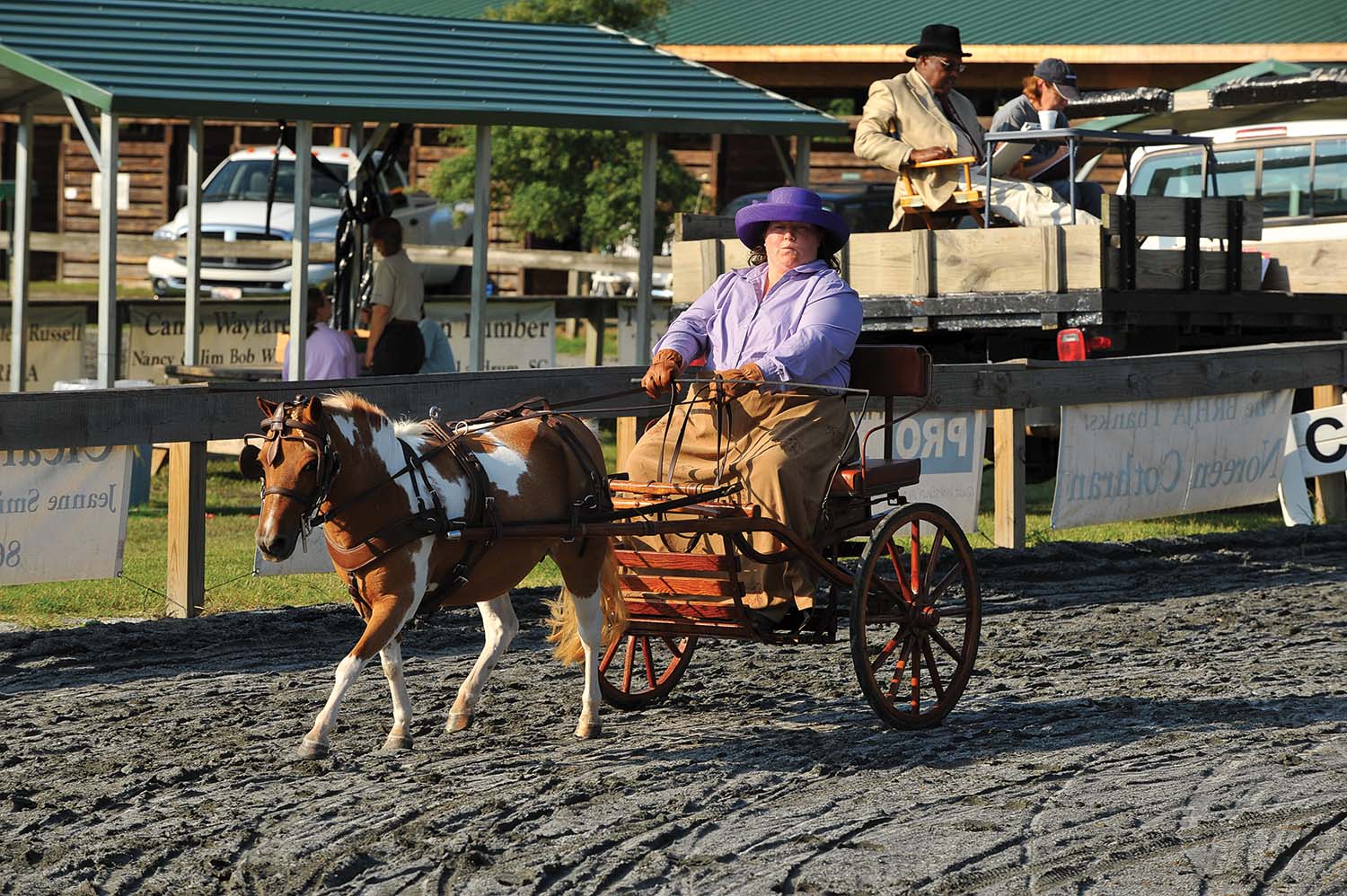
Carolina Carriage Club member Karen Payne and Midget. Photo by HoofClix.com
When we think of horse-drawn carriages, if it’s not a wagon pulling a pioneer family westward, it’s lovers riding at night through New York City’s lighted Central Park in a gilded carriage drawn by high-stepping steeds. You can almost smell the wine and roses. Or the experience might entail being stuck behind a crowded horse-drawn tourist carriage stalled in the narrow streets of downtown Charleston (in which case the wine-and-roses aroma does not apply).
As enchanting or disenchanting as those scenarios might be, serious horse-drawn-carriage driving is far more complex — a specialized equestrian way of life practiced in many forms by the Carolina Carriage Club.
“I would say that horses in harness was a way of life for a long time,” says Susan Holt. She’s referring not to the pre-automobile era but to her own enduring passion for the hobby. “My husband Stan was fool enough to buy me a riding horse as a wedding gift [in 1971],” she continues. “And since that gift, there has never been a time when there hasn’t been a horse somewhere close to us.”
Susan and Stan own Barefoot Farms in Forest City and are six-year members of the CCC, headquartered at Foothills Equestrian Nature Center in Tryon. Holt says that all of their horses — 9 standard and 27 miniature — pull a wheeled vehicle of some kind. “I especially love to drive my miniature horses,” she says. Holt owns 14 carts/carriages, everything from a family cart — her youngest daughter still lives at home — to a small “marathon” vehicle (a lightweight conveyance with motorcycle-like tires, meant to navigate obstacles in competition). “I have a beautified road gig that’s hunter green with antique gold accents,” she notes. “It’s for a large pony or medium horse.”

Alphonso Hardgrove in the ring. Photo by HoofClix.com
The combinations of different horses and carriages is almost endless, and thus the regional club maintains a list of competitive, educational, and leisure events available to its members. The sport thrives in the Polk County foothills — North Carolina’s horse country. “We have members from all over North and South Carolina, Georgia, and the rest of the Southeast,” former president Price Story confirms. Holt talks about the advantage in the design of the lower dip of the Appalachian mountains — “an eddy” that keeps the weather especially temperate for equestrian sports. Many club trials and other casual events are held at Windridge Farm in Cleveland County; owned by Alicia and Dave Henderson, it’s one of few facilities that hosts both mounted and carriage events.
Like many equestrian activities, carriage riding can be a showy spectacle, as well as competitive, technical, and athletic. Story claims there are too many types of carriages to list, but the range runs from two-wheeled antique carts to rugged trail vehicles to heavy work carriages fit for draft horses.
“And any horse can succeed at carriage driving,” adds Story. “Many of us start with our children’s outgrown pony. At a pleasure show, it isn’t uncommon to see everything from a mini donkey to a draft cross in the warm-up.” Typical larger breeds include Welsh, Morgans, Dartmoors, and Haflingers.
As the Carolina foothills transition from winter to spring, the club is now getting ready for its driving season. “During the winter months, the trails close due to weather and potentially slippery footing. Once it warms up and the weather is good and the footing is better, they reopen them for use,” explains current club president Karen Payne. “Spring is a great time for driving. It’s not too hot yet and it’s not cold. We have to take our equine partners into account for the weather, also. There isn’t really enough snow in the area for sleighs, so winter activities are less than [in] warmer months.
And yet, “the carriages take time to maintain, and winter weather can be hard on them,” she notes. But you don’t have to own a carriage to be involved with the Carolina Carriage Club. In fact, you don’t even have to own a horse. Some folks are social members who just enjoy hanging out at the barns, watching events, and pitching in when needed.
While big-stakes dressage and jumping events may get more press, Holt notes that “mounted and carriage events have the same motivation: to demonstrate the physical and aesthetic wonder of horse and rider/driver.” Like nearly all sports, though, equestrian sports can be limited by the age of not only the horse but the riders as well. However, horse-and-carriage activities can give both a few more years of enjoyment. “Many of our local equestrians are aging and losing the ability to be able to physically ride horses,” Payne explains. “Driving gives them a way to still enjoy equestrian sports.”
Though keeping horses is never cheap, carriage driving is at the low range of the cost spectrum compared to elite events. The Carriage Super Store in Greer, SC lists a “lightweight breaking cart” with 20-inch wheels for $250, and it goes up from there, into the $2,000-$6,000 range for custom four-wheel models.
Carriage riding will get a boost of awareness when the much-heralded World Equestrian Games comes to the Tryon International Equestrian Center in September. “It will bring a spotlight to some sports not normally seen in this area,” Payne predicts.
The Carolina Carriage Club holds events in the Tryon area throughout the year. The American Driving Society-recognized Horse Driving Trial event happens Saturday, May 19 and Sunday, May 20 at Windridge Farm in Mooresboro. For more information, see carolinacarriageclub.com.
